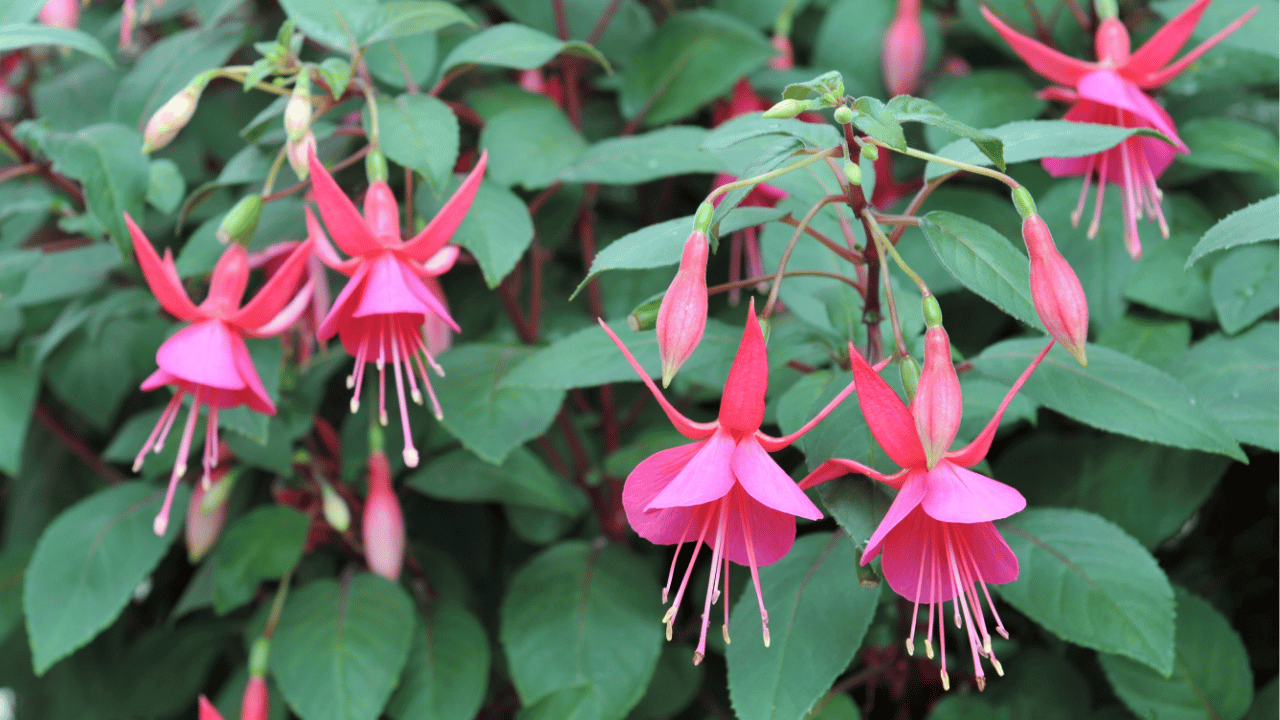Fuchsia plants are beloved for their vibrant, pendulous flowers that add beauty to any garden. Although they may seem delicate, these stunning plants can thrive with the right care. By focusing on their specific needs, such as light, water, and pruning, you’ll ensure that your fuchsia blooms abundantly and remains healthy year after year. Here are ten essential tips to help you give your fuchsia plants the attention they deserve.
1. Provide Partial Shade
Fuchsia plants flourish best in partial shade, where they can enjoy bright, indirect sunlight. While they tolerate morning sun, the harsh rays of midday and afternoon can scorch their delicate leaves and flowers. Position your fuchsias in a spot where they get enough light to grow but are shielded from the hottest parts of the day.
If growing fuchsias in containers, you can easily move them to protect against excessive sunlight. Gardens with dappled light or filtered shade under trees are ideal spots. Ensuring the right light balance prevents stress, allowing your fuchsia to focus energy on producing vibrant blooms.
2. Water Consistently, but Avoid Overwatering
Fuchsia plants thrive in consistently moist soil, but they are highly sensitive to waterlogged conditions. Overwatering can lead to root rot, which is often fatal for these plants. Ensure that the soil is well-draining and check moisture levels frequently, especially during warm weather.
Water deeply when the top inch of soil feels dry to the touch. Be particularly mindful of container-grown fuchsias, as they tend to dry out faster than those planted in the ground. A saucer or a drip tray can be helpful but always empty it to avoid standing water.
3. Use Fertilizer Regularly
Regular feeding ensures that your fuchsia plant gets the nutrients it needs to grow strong and produce flowers. A balanced, water-soluble fertilizer with equal parts nitrogen, phosphorus, and potassium works best. Feed your plant every two to four weeks during the growing season.
Take care not to over-fertilize, as excessive nutrients can cause leggy growth and fewer blooms. Follow the instructions on the fertilizer label carefully, and taper off feeding as the weather cools in the fall to help your plant enter dormancy.
4. Prune to Encourage Bushier Growth
Pruning is essential for keeping fuchsia plants tidy and promoting bushy growth. In early spring, before the growing season starts, cut back weak or leggy branches by about a third. This stimulates new, vigorous growth and increases the number of flowering shoots.
Additionally, remove any dead or damaged wood as soon as you spot it throughout the year. This practice keeps the plant healthy and ensures that energy is directed toward productive branches, rather than wasted on maintaining unhealthy ones.
5. Maintain Humidity for Indoor Plants
If you’re growing fuchsias indoors or in a greenhouse, humidity levels play a crucial role. These plants thrive in environments where humidity is moderate to high, around 50-60%. Dry indoor air, especially during the winter months, can cause the leaves to dry out or the flowers to drop prematurely.
To maintain humidity, mist your plants regularly or place a humidity tray nearby. Avoid placing fuchsias near heating vents or radiators, which can dry out the air and stress the plant. Keeping humidity levels steady will help your indoor fuchsia stay lush and vibrant.
6. Repot Every 1-2 Years
Fuchsias grown in containers need repotting every one to two years to ensure they continue thriving. The roots eventually outgrow their space, which can lead to poor growth and reduced flowering. Choose a pot that’s slightly larger than the current one and refresh the soil with a nutrient-rich, well-draining mix.
When repotting, gently shake off old soil from the roots and trim any that appear damaged or unhealthy. Repotting gives the plant more room to grow, refreshes the soil’s nutrient content, and encourages healthier, more vigorous blooms.
7. Protect from Pests
Fuchsias are susceptible to several pests, including aphids, spider mites, and whiteflies, which can weaken the plant if left unchecked. Regularly inspect your plants for signs of infestation, such as yellowing leaves or webbing on the stems.
If you notice pests, treat the plant promptly with insecticidal soap or neem oil. For severe infestations, pruning away heavily affected areas can help control the problem. Keeping pests at bay ensures that your fuchsia remains healthy and continues to produce beautiful flowers.
8. Mulch to Keep Soil Moist
Mulching around the base of your fuchsia plants helps retain moisture in the soil and keeps the roots cool during hot weather. Organic mulches, like bark chips or compost, are particularly effective as they also enrich the soil as they break down.
Apply a layer of mulch about two to three inches thick, taking care not to pile it directly against the stem. Mulching reduces water evaporation, helps control weeds, and creates an ideal environment for your fuchsia to grow.
9. Pinch Back New Growth for Fuller Plants
Pinching back the tips of your fuchsia plant’s stems is a simple technique to encourage a fuller, more compact growth habit. This process stimulates the plant to branch out, leading to more blooms. Pinch back new growth early in the season once the plant has established several sets of leaves.
Repeat this pinching process every few weeks until midsummer to maximize bushiness. By mid-July, stop pinching to allow the plant to focus on flowering. This hands-on care results in a denser, more floriferous fuchsia.
10. Prepare for Winter Dormancy
Fuchsias are tender perennials and may need special care to survive the winter, especially in colder climates. For outdoor fuchsias, cut them back in late autumn and apply a thick layer of mulch or straw to insulate the roots from freezing temperatures.
If your area experiences harsh winters, consider bringing container-grown fuchsias indoors or moving them to a sheltered spot. Keep them in a cool, frost-free location and water sparingly until spring. Proper winter care ensures your fuchsia will return healthy and vibrant the following season.

